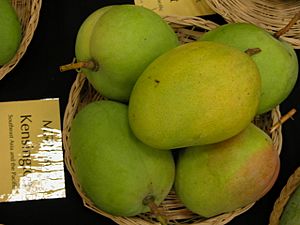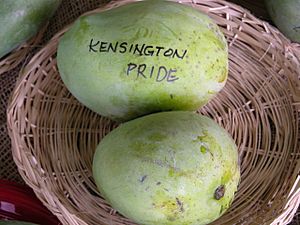Kensington Pride facts for kids
Quick facts for kids Mangifera 'Kensington Pride' |
|
|---|---|

Display of 'Kensington' mango at the 15th Annual International Mango Festival at the Fairchild Tropical Botanic Garden in Coral Gables, Florida
|
|
| Genus | Mangifera |
| Species | Mangifera indica |
| Cultivar | 'Kensington Pride' |
| Origin | Australia |
The 'Kensington Pride' mango is a special type of mango that first grew in Australia. People sometimes call it the KP, Bowen, or Bowen Special. It is Australia's most popular mango. In fact, it makes up over 80% of all the mangoes sold there each year! This mango is known for its unique taste and smell. Many people think it tastes different from mangoes grown in Florida, USA.
In Australia, 'Kensington Pride' mangoes are mostly grown in the Northern Territory and in northern and central Queensland. These areas provide mangoes early in the season (from September to November) and later in the season (from December to February). Some mangoes that ripen later come from the Kununurra area in Western Australia. Not many of these mangoes are grown in south-east Queensland or northern New South Wales. Mangoes from these places are usually not as good quality.
History of the Kensington Pride Mango
The very first 'Kensington Pride' mango tree appeared in Bowen, Queensland in the late 1880s. At first, people called this fruit "Pride of Bowen" or "Bowen Special". It might have been brought to Bowen from India between 1885 and 1889. Traders who were shipping horses to India could have carried the mango seeds.
The way this fruit grows suggests it might have come from Southeast Asia. This is because its seeds can produce more than one plant (this is called polyembryonic). However, its shape and color are very similar to mangoes from India. This means it could be a mix of different types.
One story says that a customs officer named GE Sandrock received a special mango. He planted its seeds on his land. As the trees grew, Mr. Sandrock picked seeds from the best fruits. He then gave these seeds to a Mr. McDonald for his own farm. From Mr. McDonald's trees, another local farmer named Mr. Harry Lot chose a very good type. He started his own small mango farm near Bowen. The mangoes from his farm became very popular in local markets. They were named 'Kensington' after his original property. Other farmers soon got their own trees, and the fruit spread all over the Bowen area.
The 'Kensington Pride' mango became famous for its great taste. It grew to be the most popular commercial mango in Australia. Even today, it remains the top choice, even though other types of mangoes have been introduced. It is grown widely in the warm, tropical parts of Australia. 'Kensington Pride' mangoes were also brought to the United States, specifically to Florida. There, they are sold in small amounts for people to grow at home. 'Kensington' trees are also kept in important plant collections. These include the USDA collection in Miami, Florida, and the Fruit and Spice Park in Homestead, Florida.
What Does a Kensington Pride Mango Look Like?

When fully grown, these mangoes usually weigh about 500 grams (about 1.1 pounds). They are oval-shaped and have a rounded top. The skin is yellow, and it can develop some red color as it ripens. The inside of the mango (the flesh) is yellow. It has a moderate amount of fiber. The taste is sweet and a little bit spicy. Each fruit has a polyembryonic seed. This means that one seed can grow into two different seedlings.
When and Where are Kensington Pride Mangoes Grown?
In Australia, 'Kensington Pride' mangoes usually ripen from mid-September to March. The exact time depends on where they are grown. Sometimes, they can ripen as early as August in the Northern Territory. In Florida, USA, they typically ripen in July.
Growing 'Kensington Pride' mangoes can be a bit tricky in Australia. The amount of fruit they produce can change a lot from year to year. Also, they have a moderate ability to resist diseases. The trees are known for being very unpredictable. The number and quality of mangoes can vary greatly from one year to the next.
In Australia, the mango season moves from north to south. It starts near Darwin and Katherine in late September. It usually finishes by early December. Mangoes from Queensland (like from Mareeba, Dimbulah, Townsville, Bowen, and Yeppoon) start appearing around this time. They stay on the market well into January. In the 1990s and 2000s, many more mangoes started coming from the Northern Territory.
The trees themselves grow quite strongly. If they are not trimmed, they can reach heights of over 8 meters (about 25 feet).

